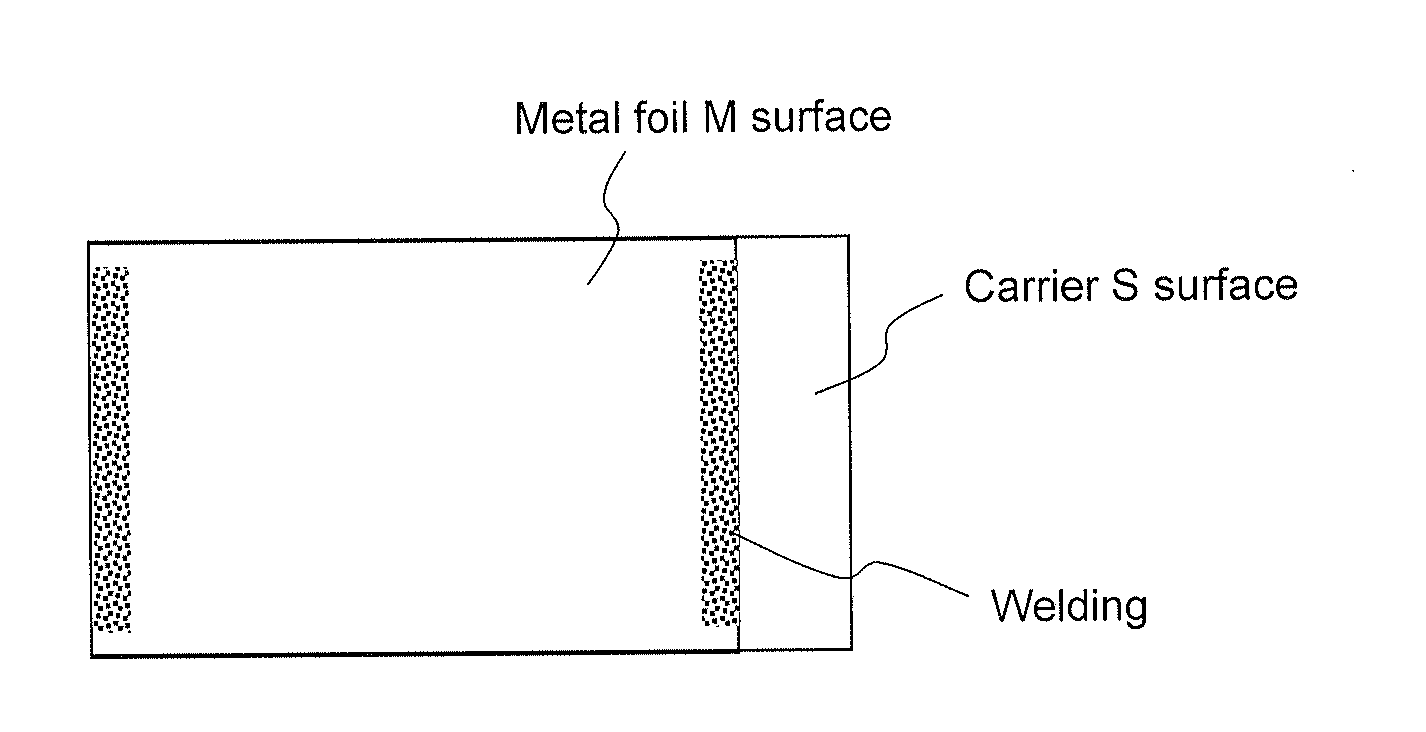Metal Foil with Carrier
- Summary
- Abstract
- Description
- Claims
- Application Information
AI Technical Summary
Benefits of technology
Problems solved by technology
Method used
Image
Examples
example 1
[0073]A prepreg prepared from epoxy resin was used as the resin material. An intended number of prepregs were laminated on the metal foil with a carrier, a two-layer printed circuit board referred to as an inner layer core was subsequently laminated thereon, a prepreg was subsequently laminated thereon, and a metal foil with a carrier was further formed thereon, in the foregoing order, in order to complete one set of a four-layer substrate material assembly unit.
[0074]Subsequently, this unit called “page” was repeatedly laminated about 10 times to configure a press assembly called “book”.
[0075]The present invention is unique with respect to the structure of the metal foil with a carrier, and comprises a structure where the carrier A protrudes from the metal foil B. FIG. 4 shows this structure.
[0076]FIG. 4 shows a case of forming a four-layer substrate unit called “page” obtained by laminating, in order, a metal foil with a carrier, intended number of prepregs, two-layer printed circ...
example 2
[0084]As with Example 1, a prepreg prepared from epoxy resin was used as the resin material. An intended number of prepregs were laminated on the metal foil with a carrier, a two-layer printed circuit board referred to as an inner layer core was subsequently laminated thereon, a prepreg was subsequently laminated thereon, and a metal foil with a carrier was further formed thereon, in the foregoing order, in order to complete one set of a four-layer substrate material assembly unit.
[0085]Subsequently, this unit called “page” was repeatedly laminated about 10 times to configure a press assembly called “book”.
[0086]The present invention is unique with respect to the structure of the metal foil with a carrier, and comprises a structure where the carrier A protrudes from the metal foil B. Copper was used for both the carrier A and the metal foil B. FIG. 5 shows this structure. FIG. 5 may appear to have the same structure as FIG. 4, but there are differences that are not shown, and, as de...
example 3
[0092]The roughened surface of the rolled copper foil of the carrier A and the S surface of the electrolytic copper foil of the metal foil B were bonded using the ultrasonic welding method. Otherwise, a book was prepared as with Example 2, and the foregoing book was placed in a hot press and subject to compression molding at a prescribed temperature and pressure to produce a four-layer substrate. The laminated plate prepared as described above was formed into a completed product by forming a circuit by undergoing plating process and / or etching process, and further peeling and separating the carrier and the copper foil.
[0093]With this peeling and separation, the configuration of this Example did not result in any rupture of the copper foil or residual copper carrier on the copper foil, though in the case of Example 2, the copper foil after the peeling and separation had slightly ruptured and the copper carrier slightly remained on the copper foil.
[0094]Accordingly, it was discovered ...
PUM
| Property | Measurement | Unit |
|---|---|---|
| Area | aaaaa | aaaaa |
Abstract
Description
Claims
Application Information
 Login to View More
Login to View More - R&D
- Intellectual Property
- Life Sciences
- Materials
- Tech Scout
- Unparalleled Data Quality
- Higher Quality Content
- 60% Fewer Hallucinations
Browse by: Latest US Patents, China's latest patents, Technical Efficacy Thesaurus, Application Domain, Technology Topic, Popular Technical Reports.
© 2025 PatSnap. All rights reserved.Legal|Privacy policy|Modern Slavery Act Transparency Statement|Sitemap|About US| Contact US: help@patsnap.com



